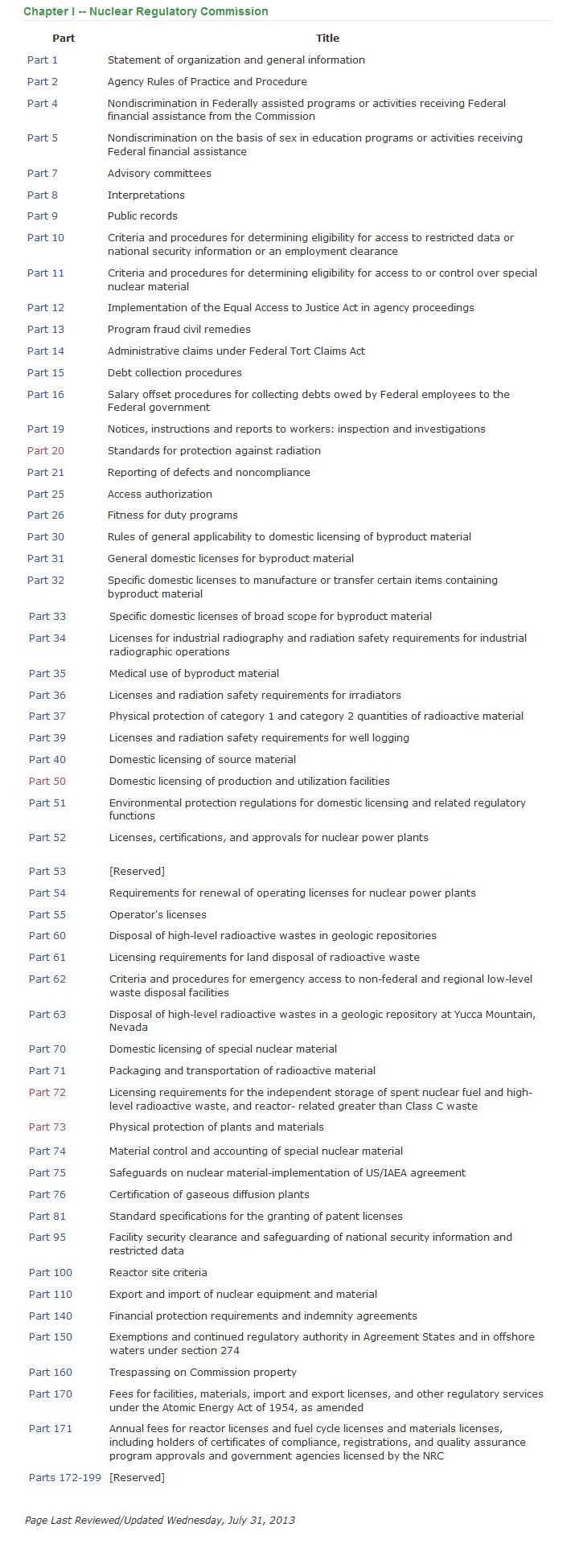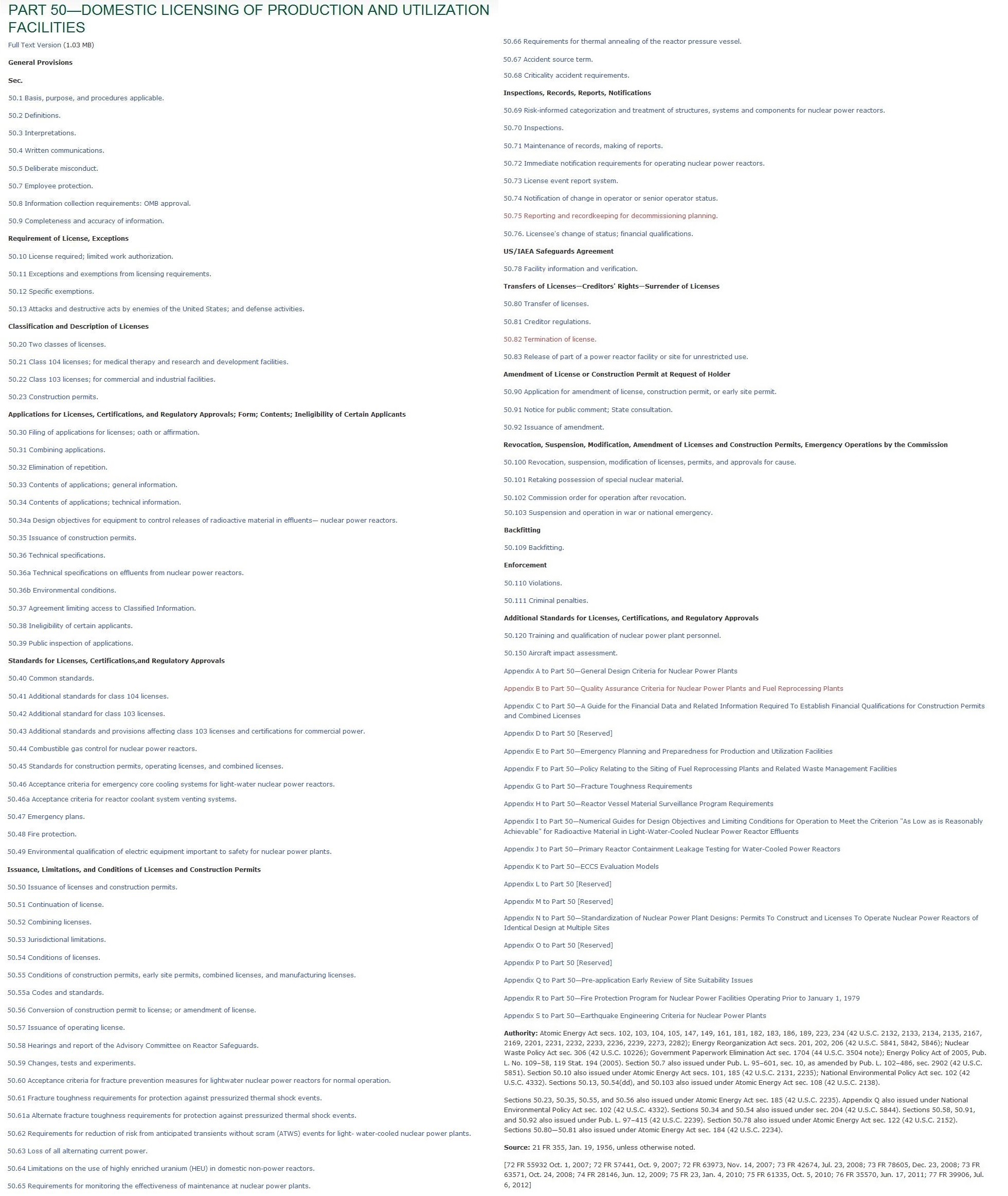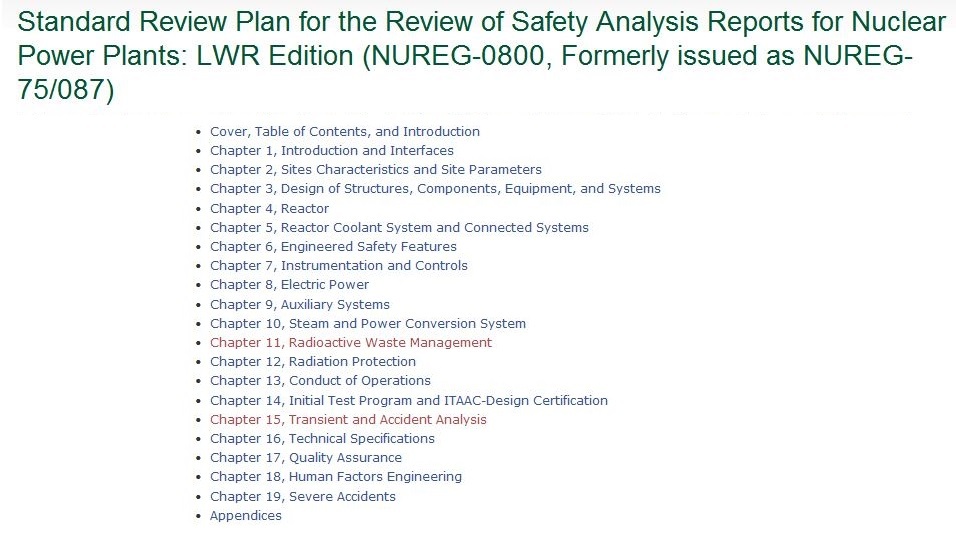Code of Federal Regs, Title 10
The Nuclear Regulatory Commission’s regulations for nuclear power plant safety are largely embodied in Title 10 of the Code of Federal Regulations. An archive file of the current 10 CFR regulations can be downloaded from the NRC’s webpages. I don’t know if there’s an app for that.
Title 10 of the Code of Federal Regulations consists of dozens of parts including Part 20, Standards for Protection Against Radiation; Part 26, Fitness for Duty Programs; Part 50, Domestic Licensing of Production and Utilization Facilities; Part 73, Physical Protection for Plants and Materials; and Part 100, Reactor Site Criteria (see Figure 1).
Part 50 covers the licensing of existing nuclear power reactors (Part 52 covers licensing of new reactors and Part 54 covers renewal of operating licenses) (see Figure 2). It consists of dozens of sections and more than a dozen appendices. Section 50.36 covers the technical specifications that form an integral part of each reactor operating license. Section 50.72 covers the requirements for owners promptly informing the NRC of certain conditions while Section 50.73 covers the requirements for followup written reporting.
Where’s the cheese among this regulatory maze? As is suggested by the two graphics (and by many, many more other information within 10 CFR not illustrated), finding the relevant regulation can be challenging.
NRC Standard Review Plan
Perhaps the second best guide to the cheese is the NRC’s Standard Review Plan for the safety analysis reports for nuclear power plants. The NRC developed this Standard Review Plan as a tool to be used by its staff in reviewing applications for reactor operating licenses as well as requests by owners to revise or amend reactor operating licenses. The Standard Review Plan indicates the applicable regulations from 10 CFR as well as methods accepted by the NRC for demonstrating compliance with the regulations (see Figure 3).
For example, Chapter 8 of the Standard Review Plan covers electric power systems. Within this chapter, Section 8.4 addresses Station Blackout regulatory requirements. Station blackout was the major problem faced in the March 2011 disaster at Fukushima Daiichi in Japan. This section indicates that regulations 10 CFR 50.63, 10 CFR 50.65, and Criteria 17 and 18 within Appendix A to 10 CFR Part 50 apply. This section further indicates that Regulatory Guide 1.155 describes methodology acceptable to the NRC for complying with these applicable regulatory requirements
Chapter 2 of this Standard Review Plan covers siting issues. Section 2.4.6 addresses potential tsunami hazards, a primary contributing factor to the Fukushima disaster. Section 2.4.4 addresses an area currently being re-examined by the NRC – potential dam failures.
Chapter 5 of this Standard Review Plan covers the reactor coolant system. Sections 5.4.2.1 and 5.4.2.2 cover steam generators in pressurized water reactors, issues that factored into the recent permanent shut down of two untis at the San Onofre nuclear plant in California. Sections 5.4.6 and 5.4.13 address the reactor core isolation cooling system and isolation condenser systems respectively that played roles, ultimately futile, at Fukushima.
Chapter 13 addresses requirements related to operating the reactors. Section 13.2.1 covers the training and retraining of reactor operators. Section 13.3 covers emergency planning requirements. Section 13.6 covers protection of nuclear power plants from sabotage and theft of nuclear materials.
The NRC has also developed Standard Review Plans for other activities it regulates, including the following:
- Dry storage facilities for spent fuel
- Plans for terminating operating reactor licenses (the issue presenting being confronted by the owners of the San Onofre, Kewaunee, and Crystal River 3 reactors that permanently shut down in 2012)
- Funds set aside to decommission nuclear power reactors
- Environmental reports required under NEPA
- Renewing the operating licenses of nuclear power reactors.
These Standard Review Plan can be a helpful guide to identifying regulatory requirements applicable to a component (e.g., emergency diesel generators) or topic (flooding protection) as well as to the criteria accepted by the NRC for showing compliance. A Standard Review Plan is by no means a 3×5 card cheat sheet; it’s still hundreds of pages and a maze to navigate. But it is a smaller maze that is easier to navigate than the seemingly infinite breadth of the regulations themselves.
The UCS Nuclear Energy Activist Toolkit (NEAT) is a series of post intended to help citizens understand nuclear technology and the Nuclear Regulatory Commission’s processes for overseeing nuclear plant safety.



